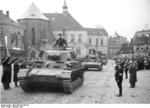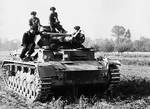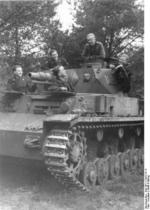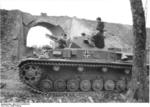PzKpfw IV
| Country | Germany |
| Manufacturer | Krupp Grusonwerke AG, Magdeburg, Germany |
| Primary Role | Medium Tank |
Contributor: Alan Chanter
ww2dbaseThe SdKfz 161 Panzerkampfwagen IV (PzKpfw IV) Medium Tank was developed to meet a 1934 requirement, from the German Army Weapons Department, for a close support tank of around 20 tons (to keep within the limits imposed by German divisional bridging equipment). It was required to be armed with a big-bore weapon better suited for usage against "soft" targets, where the high-velocity armour-piercing 3.7-cm guns or machine-guns of lighter tanks would be unsuitable. As with the PzKpfw II and III tanks, various designs were submitted by Rheinmetall-Borsig, MAN and Krupp companies. Some of these designs did not get off paper, but following tests with prototype vehicles in 1935-1936, Krupp (who had earlier lost the PzKpfw II contract to MAN) were awarded the contract for development of a production model. In so doing they would provide the German armoured forces with unquestionably the one of the finest and versatile tanks of the Second World War, and one that would, through successive modifications, become the backbone of the Wehrmacht's Panzer arm. Initially though, to get around the restrictions placed on German tank production by the peace treaty of 1919, the design was described as a Bataillonsführerwagen (BW for short) or "Battalion Commander's vehicle".
ww2dbaseIn outward appearance the PzKpfw IV was of similar design to the PzKpfw III Tank, but with a larger turret to mount a short-barrelled 75-mm KwK L/24 gun as the main armament. The hull was made up of electro-welded face-hardened steel plates with a large bolted superstructure on top carrying the turret ring. The three-man turret was also welded and well sloped and was sufficiently large enough to eventually permit the mounting of much larger guns with some modifications to the mantlet. Krupp's first proposal was for the suspension of the BW to be of interleaved road wheels (of the kind that were eventually to be adopted in late-war German tanks) but the form of suspension actually used throughout the long production run was much simpler. Eight road wheels either side were suspended upon paired bogies on longitudinal elliptical springs; the idler wheel was raised off the ground at the rear and the top run of the track was carried on four return rollers – providing an easy-to-remember recognition point for the Panzer IV. After many experiments with all the early versions of their principle tanks the Germans settled on traverse torsion bars for the PzKpfw III and quarter-elliptic leaf spring, in different layouts, for the PzKpfw IV and standard models of the PzKpfw II. This suspension arrangement provided the five-man crew with an extremely comfortable ride. The build was almost luxurious - Indeed each machine was virtually handmade instead of mass produced. The drawback to this unfortunately was that they were over-complex machines which frequently needed to be returned to the factory for repairs that were beyond the skills of Army workshops.
ww2dbaseThe engine was the well tried Maybach which also powered the III (from the Ausf E onwards). The Maybach AG had been in the business of making big engines since the day they had powered the first Zeppelin. Practically every engine used in any German armoured fighting vehicle throughout the war was designed and more often than not made by them. British tank crews for a long time went in constant fear of mechanical breakdown. For their German opposite numbers the thing was a rarity. Initially this was the twelve-cylinder Maybach HL 108TR V-12 petrol engine situated at the rear of the tank with the transmission led forward, via a dry plate clutch and gearbox, which, in the Ausf (Model) A had five forward speeds, to the final drive sprockets at the front of the track. A six-speed gearbox was substituted in the Ausf B version together with a larger 300 h.p. Maybach HL 120 TR (HL 120TRM from Ausf C model onwards) engine. Engine cooling was uniquely conducted by drawing air in at the right-hand side of the hull and, after passing through the radiator, expelling it through grilles at the left-hand side. These mechanical changes constituted the only principle differences between the first models of the PzKpfw IV, although all were very much alike externally.
ww2dbaseThe armour basis of the hull of the PzKpfw IV Ausf A was 14.5-mm, and of the turret 20-mm. The frontal armour in the next three models, Ausf B-D was increased to 30-mm. The short–barrelled 7.5-cm KwK L/24 (for which 122 rounds of ammunition was carried) was selected as the main armament. This gun had a muzzle velocity of 1,263 feet per second (fps) which made it particularly unsuitable for tank-versus-tank combat (although at less than 500 yards it was still capable of penetrating 40-mm of armour – though few tanks of the day had armour as thick as this). The round itself weighed 15 pounds. In addition there was a coaxial turret machine-gun in all tanks of the series, and all except Ausf. B and C models had another MG34 machine gun mounted in the front of the hull to the right of the driver.
ww2dbaseProduction of the PzKpfw IV commenced in 1937 but got underway rather slowly as it was originally intended that fewer would be needed than the Panzer III. By the start of the Polish invasion in September 1939, however, only 211 early models of Panzer IV had been delivered (and even fewer PzKpfw IIIs). Combat experience in Poland suggested a need to increase the armour thickness at the front of the hull to 60-mm, and at the sides to 40-mm, and this was incorporated into the next model (Ausf D) although the design was otherwise left unchanged except for minor details. Some 278 Panzer IVs of all models were available at the beginning of the campaign in the west in May 1940.
ww2dbaseProduction was stepped up during 1940 with more than 1,000 delivered by the end of 1941. Combat on the Eastern Front however revealed that the armour was still insufficient and so the next model, Ausf E, was up-armoured to 60-mm frontal and 30-mm to 40-mm on the sides, increasing the vehicle's all-up weight to 22 tons. On the Ausf F the frontal armour reached 80-mm (50-mm plus 30-mm appliqué), with other changes included wider tracks, new welded-tubing sprockets and a different pattern idlers. Nevertheless it was becoming apparent, even at this stage in the war that the L/24 gun, was only capable of tackling the Russian T-34 from the rear, and so an emergency programme of up-gunning had to be considered.
ww2dbaseIntroduced in early 1942, the Ausf F-2 mounted, in a modified turret, the long-barrelled 7.5-cm KwK 40 L/43 gun in place of the L/24. The PzKpfw IV could now take on the task of the PzKpfw III, namely that of fighting other tanks (and for two years it was the only German tank capable of holding its own with the T-34). The British in North Africa labelled the Ausf F-2 model the "Panzer IV Special" (the up-gunned PzKpfw IIIs were similarly named "Panzer III Special"). Fortunately few were sent to Africa (the first four delivered to Erwin Rommel could not be employed in the Battle of Gazala due to the non-supply of suitable ammunition) and even by the Battle of El Alamein Rommel had only thirty-seven (from 200 German tanks available) of this valuable weapon available.
ww2dbaseThe muzzle velocity of the L/43 weapon was more than double that of the earlier L/24, 900 metres per second compared with 450; the range was 8,100 compared with 6,500 metres (high explosive, not armour-piercing); and armour-piercing capability was 89-mm at 500 yards' range compared with only 41-mm for the L/24. Muzzle velocity was crucial in determining the effectiveness of a tank gun when firing solid shot, as it ensured longer range and better penetration with hollow-charge projectiles. With this gun the PzKpfw IV had a much improved ability to tackle the latest Allied tanks (including the new American Grants also armed with a 75-mm gun which was easily outranged). Not surprisingly, when it was seen to be successful and capable of standing up to the best of Allied and Soviet vehicles there was an urgent call for more, which was only met with difficulty. The only visible difference between the Ausf F2 and the Ausf G, which was the last production version to see action in North Africa, was its double baffle muzzle brake.
ww2dbaseBy 1944 the most common variant in use was the 25-ton Ausf H. This model, which entered service in March 1943, still powered by the Maybach engine, had a top speed of 40 km/h (25 mph) and a range of 200 km (125 miles). The maximum armour protection of 80-mm was normally supplemented with additional "spaced" armour (or wire mesh, in some cases) around the turret and hull sides to give the tank extra protection against Allied hollow-charge anti-tank projectiles. The concept behind this was that a hollow-charge missile would explode between the side skirts and the armoured hull of the tank thus inflicting less damage. Most German tanks by this stage were also normally painted with "Zimmerit", an applied anti-magnetic paste to repel sticky bombs. The PzKpfw IVH was better armed with a 7.5-cm KwK 40 L/48 gun which had a muzzle velocity of or 3,248 feet-per-second (990 m/s). Eighty-seven rounds were carried for the main gun plus together with 3,000 rounds of machine-gun ammunition.
ww2dbaseThe Ausf J (which appeared in March 1944) was the final version PzKpfw IV to be built. It was very similar externally to the preceding model but incorporated detail changes. One of the most important (and a retrograde step) was the deletion of a turret power traverse system, in order to make room for increased fuel capacity (680 litres, compared with 470 for the Ausf H) to give the extra range called for by 1944.
ww2dbaseBy the end of the war about 9,000 PzKpfw IV tanks had been built and it was the only German tank to be in continuous production throughout the war years. Although outclassed by 1944, and perhaps continued in production longer than was desirable (mainly because of the urgent need for serviceable tanks in large numbers rather than a complete change to the new Panther would have left a dangerous shortage of medium tanks at a critical time). Nevertheless the PzKpfw IV was still a most useful tank which could take on Shermans or Cromwells at roughly equal odds. Whilst Improvements in armament and armour had been added as requirements changed, the basic chassis had remained unaltered on all models - a tribute to the soundness of the original design. Tanks which were returned to workshops for repair were regularly modified to the latest standard and the whole fleet was progressively up-dated as the new versions were introduced.
ww2dbaseLike all German tanks of the war the PzKpfw IV's chassis was widely used as the basis for various specialist vehicles such as the StuG IV assault gun, JagdPanzer IV tank destroyer, and various anti-aircraft vehicles, armoured recovery vehicles and bridge layers. Throughout its long production life, and despite progressive increases in overall weight, the PzKpfw IV through its good power-to-weight ratio, mobility characteristics, and hitting power had unquestionably served the German army extremely well.
ww2dbaseSources:
A. J. Smithers, Rude Mechanicals (Grafton Books, 1989)
Bruce Quarrie, Panzers in the Desert (Patrick Stephens, 1978)
Bruce Quarrie, Panzers in North-West Europe (Patrick Stephens, 1979)
B. T. White, Tanks and other AFVs of the Blitzkrieg Era 1939-41 (Blandford Press, 1972)
B. T. White, Tanks and other Armoured Fighting Vehicles 1942-45 (Blandford Press, 1975)
Ian V Hogg & John Weeks, The Illustrated Encyclopaedia of Military Vehicles (Hamlyn, 1980)
Len Deighton, Blitzkrieg: From the rise of Hitler to the fall of Dunkirk (Triad Granada, 1980)
Philip Trewhitt, Armoured Fighting Vehicles (Dempsey Parr, 1999)
Ronald Lewin, The Life and Death of the Afrika Korps (Corgi, Books, 1979)
Last Major Revision: Nov 2012
SPECIFICATIONS
Ausf F2
| Machinery | One 11,867cc Maybach HL 120 TRM, V-12 water-cooled petrol engine developing 300hp (224Kw) at 3,000rpm |
| Armament | 1x75mm KwK 40 (L/43) gun, 1x7.92mm co-axial mounted machine gun, 1x7.92mm machine gun in hull |
| Armor | 10-50mm |
| Crew | 5 |
| Length | 5.40 m |
| Width | 2.86 m |
| Height | 2.65 m |
| Weight | 23.2 t |
| Speed | 38 km/h |
| Range | 209 km |
Photographs
 |  |  |  |
Did you enjoy this article or find this article helpful? If so, please consider supporting us on Patreon. Even $1 per month will go a long way! Thank you. Share this article with your friends: Stay updated with WW2DB: |
Visitor Submitted Comments
18 Nov 2009 01:46:43 PM
The Panzer IV was built in many variants
during the war.
Some of the models are:
Flakpanzer IV Wirberwind mounting anti-
aircraft guns. Others were rebuilt into
assault guns.
Bruckenleger: bridgelaying vehicle.
Brummbar: (Grizzly Bear) 300 were built
between 1943 and 1945, many were rebuilt Panzer IV Ausf.F,G,and H chassis these
carried the massive 150mm Infantry Howitzer
Munitionsschlepper: that carried the shells
for the 280mm K5 Railway Gun, and for the
Morser Karl-Gerat.
Prototype: Panzer IV that carried the 10.5cm
howitzer. The German arms industry rebuilt
the workhorse Panzer IV into many different
models.
14 Dec 2010 02:58:27 PM
Early models of the Panzer Mark IV were armed
with a low-velocity 75mm gun.
In 1941 after meeting the Russian T-34 tank,
the Mark IV was equipped with a more powerful
75mm L/43 anti-tank gun.
Other design improvements created the Mark IV
mounting a long barrel 75mm L/43.
This model remained basically unchanged only
for upgrades in armor and armament.
The Mark IV was also supplied to Germany's
Axis Allies in Europe.
MARK IV LATE VARIANTS
The Mark IV was improved with firepower and
sighting systems, this gave an edge to the
Panzer crews facing the Russian T-34 and the
US Sherman.
Improved long barrled L/48 guns were effective against the T-34. Other upgrades
against anti-tank rounds, were skirts added to the sides, and around the turret.
The Sturmgeschutz IV was a low profile self-
propelled, anti-tank Jagdpanzer armed with a more powerful L/70 gun.
After WWII a number of Jagdpanzer IVs found their way to Syria, acquired from France and
Czechoslovakia, along with a number of
Mark IVs acquired in the 50s and 60s
16 Mar 2017 04:38:08 PM
Great read Alan. Are there any references to mesh wire schurzen on the turret of a IV?. Cheers
All visitor submitted comments are opinions of those making the submissions and do not reflect views of WW2DB.
- » WW2DB's 20th Anniversary (29 Dec 2024)
- » Wreck of USS Edsall Found (14 Nov 2024)
- » Autumn 2024 Fundraiser (7 Nov 2024)
- » Nobel Peace Prize for the Atomic Bomb Survivors Organization (11 Oct 2024)
- » See all news
- » 1,150 biographies
- » 337 events
- » 44,024 timeline entries
- » 1,242 ships
- » 350 aircraft models
- » 207 vehicle models
- » 375 weapon models
- » 123 historical documents
- » 260 facilities
- » 470 book reviews
- » 28,621 photos
- » 431 maps
James Forrestal, Secretary of the Navy, 23 Feb 1945
Please consider supporting us on Patreon. Even $1 a month will go a long way. Thank you!
Or, please support us by purchasing some WW2DB merchandise at TeeSpring, Thank you!
30 Oct 2009 08:50:23 PM
The Panzer IV was the backbone of the Panzer Divisions. Development was begun by Krupp in
1934. During its production, the vehicle was
improved in both armor and weapons.
The Panzer IV was still a threat on the
battlefield, and was in service until the end
of the war.
The vehicle was built in different variants:
ammunition transporter, bridgelaying and a
recovery vehicle,also built as self-propelled
guns. Around 9,200 were built. The Panzer IV
were also supplied to Germany's allies.
After World War II France and Czechoslovakia
used the tank into the 1950's.
The Syrian Army bought a number of Panzer IV
from France, Czechoslovakia and Russia that
sold them cheaply from their stocks of captured tanks.
Variants used were the StuG III Assault Gun besides the Panzer IV. The last Panzer IV's
in service were probably used as late as 1973 on the Golan Heights.
The old warrior gets around:
German tanks were passed from France and
Czechoslovakia also from Spain, and a handful
were sold to Batista's Army in Cuba in 1958-
59.